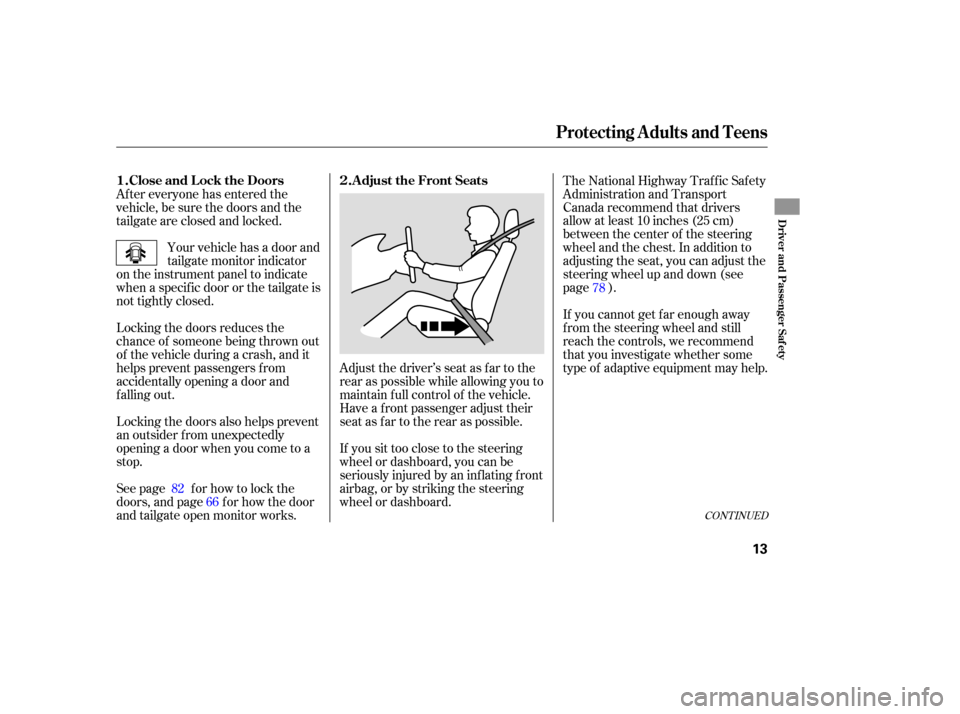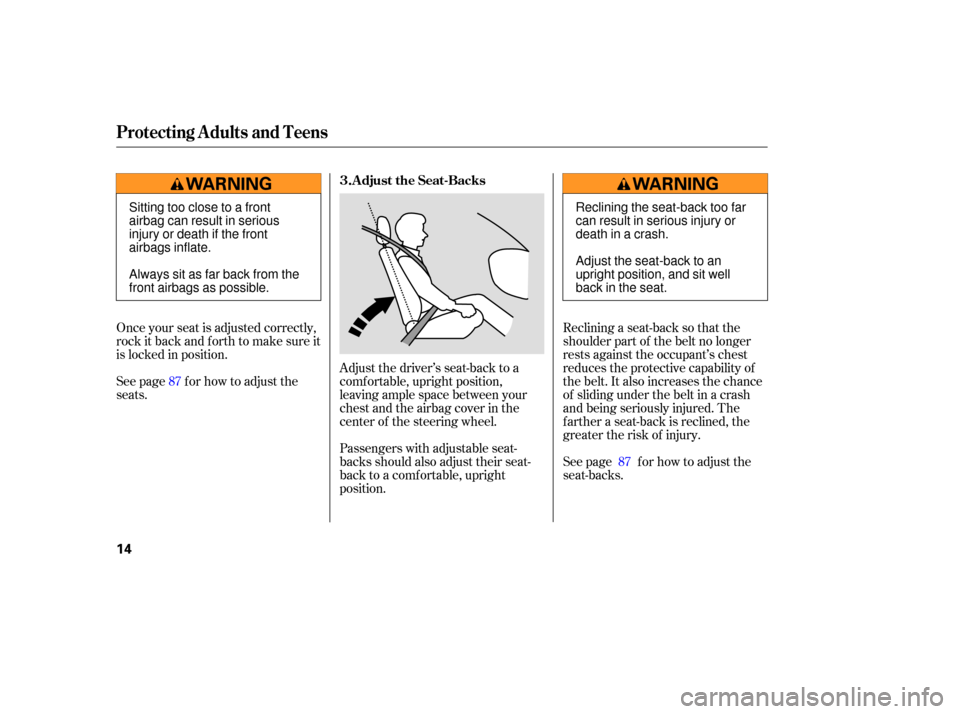Page 8 of 319
�Î�Î
�Î �Î
�Î
�Î �Î
If equipped. To use the horn, press the pad around the ‘‘H’’ logo.
1: :
Your Vehicle at a Glance
Your Vehicle at a Glance
5
LIGHT CONTROL
SWITCH
STEERING WHEEL
ADJUSTMENT WINDSHIELD WIPERS/
WASHERSREAR WINDOW
DEFOGGER
PASSENGER AIRBAG
OFF INDICATOR
(P.
96)
(P. 102) (P.
75)
MOONROOF BUTTONS
(P. 204)
VTM-4 LOCK
(P. 35)
(P. 77)
(P. 74)
REMOTE AUDIO
CONTROLS
(P.
138) (P. 78)
(P. 175)
CRUISE CONTROL
BUTTONS
VSA OFF SWITCH
(P.
212)
CRUISE CONTROL
MASTER BUTTON
(P. 175) HAZARD WARNING BUTTON
(P. 77)
HORN
HEADLIGHTS/TURN SIGNAL/FOG LIGHTS
1
1
1 1
Page 15 of 319

�µ
See pages for important
guidelines on how to properly
protect infants, small children, and
larger children who ride in your
vehicle.
The
most important things you need
to know about your airbags are:
They are designed to supplement
the seat belts.
Remember however, that no safety
system can prevent all injures or
deaths that can occur in a severe
crash, even when seat belts are
properly worn and the airbags deploy.
The
rest of this section gives more
detailed information about how you
can maximize your safety.Always
wear
your seat belt properly, and sit
upright and as far back from the
steering wheel as possible while
allowing full control of the vehicl e. A
front passenger should move their
seat as far back from the dashboard
as possible.
To do their job, airbags must
inflate with tremendous force. So
while airbags help save lives, they
can cause minor injuries or more
serious or even fatal injuries if
occupants are not properly
restrained or sitting properly. The f ollowing pages provide
instructions on how to properly
protect the driver, adult passengers,
and teenage children who are large
enough and mature enough to drive
or ride in the f ront seat.
38 56
Your Vehicle’s Saf ety Features, Protecting A dults and Teens
Protecting A dults and T eens
Introduction
Airbags do not replace seat belts. What you should do:
Airbags can pose serious hazards.
A irbags of f er no prot ect ion in rear
impact s, or minor f ront al or sidecollisions.
12
Page 16 of 319

If you cannot get far enough away
from the steering wheel and still
reach the controls, we recommend
that you investigate whether some
type of adaptive equipment may help.
Your
vehicle has a door and
tailgate monitor indicator
on the instrument panel to indicate
when a specific door or the tailgate is
not tightly closed. The
National Highway Traffic Safety
Administration and Transport
Canada recommend that drivers
allow at least 10 inches (25 cm)
between the center of the steering
wheel and the chest. In addition to
adjusting the seat, you can adjust the
steering wheel up and down (see
page ).
After
everyone has entered the
vehicl e, be sure the doors and the
ta ilgate are closed and locked.
Locking the doors reduces the
chance of someone being thro wn out
of the vehicle during a crash, and it
helps prevent passengers from
accidentally opening a door and
falling out.
Locking the doors also helps prevent
an outsider from unexp ectedly
opening a door when you come to a
stop.
See page f or how to lock the
doors, and page f or how the door
and tailgate open monitor works. Adjust the driver’s seat as far to the
rear as possible while allowing you to
maintain f ull control of the vehicle.
Have a f ront passenger adjust their
seat as far to the rear as possible.
If you sit too close to the steering
wheel or dashboard, you can be
seriously injured by an inf lating f ront
airbag, or by striking the steering
wheel or dashboard. 78
66
82
CONT INUED
Protecting A dults and Teens
Adjust the Front Seats
Close and L ock the Doors 2.
1.
Driver and Passenger Saf ety
13
Page 17 of 319

Reclining a seat-back so that the
shoulder part of the belt no longer
rests against the occupant’s chest
reduces the pro tective capability of
the belt. It also increases the chance
of sliding under the belt in a crash
and being seriously injured. The
farther a seat-back is reclined, the
greater the risk of injury.
See page for how to adjust the
seat-backs.
Passengers
with adjustable seat-
backs should also adjust their seat-
back to a comfo rtable, upright
position. Adjust the driver’s seat-back to a
comfortable, upright position,
leaving ample space between your
chest and the airbag cover in the
center of the steering wheel.
Once
your seat is adjusted correctly,
rock it back and forth to make sure it
is locked in position.
See page f or how to adjust the
seats.
87
87
Protecting A dults and Teens
Adjust the Seat-Backs
3.
14
Reclining the seat-back too far
can result in serious injury or
death in a crash.
Adjust the seat-back to an
upright position, and sit well
back in the seat.
Sitting too close to a front
airbag can result in serious
injury or death if the front
airbags inflate.
Always sit as far back from the
front airbags as possible.
Page 29 of 319
Two SRS (supplemental restraint
system) front airbags. The driver’s
airbag is stored in the center of
the steering wheel; the front
passenger’sairbagisstoredinthe
dashboard. Both are marked ‘‘SRS
AIRBAG’’ (see page ).
Two side airbags, one for the
driver and one for a front
passenger. The airbags are stored
in the outer edges of the seat-
ba cks. Both are marked ‘‘SIDE
AIRBAG’’ (see page ).
Your
Airbag System includes:
Two side curtain airbags, one for
each side of the vehicle. The
airbags are stor ed in the ceiling,
above the side windows. The front
and rear pillars are marked ‘‘SIDE
CURTAIN AIRBAG’’ (see page ). 28
31
33
Additional Inf ormation About Your Airbags
26
(15) Rear Safing Sensor
(16) Side Impact Sensor (second)
(17) Side Curtain Airbags
(17)
(16) (15)
Page 62 of 319

This section gives inf ormation about
the controls and displays that
contribute to the daily operation of
your vehicle. All the essential
controls are within easy reach............................
Control Locations .60
............................
Instrument Panel .61
..........
Instrument Panel Indicators .62
.............................................
Gauges .70
...................................
Trip Meter .70
.....................................
Odometer .70
..................................
Fuel Gauge .70
...................
Temperature Gauge .71
Outside Temperature
...................................
Indicator .71
..........
Check Fuel Cap Message .72
Controls Near the Steering ...........................................
Wheel .73
.
Windshield Wipers and Washers .74
.................
Turn Signal, Headlights .75
Automatic Lighting Off .....................................
Feature .76
............
Daytime Running Lights .76
........
Instrument Panel Brightness .76
.................
Hazard Warning Button .77
.................
Rear Window Def ogger .77
..........
Steering Wheel Adjustment .78
...............................
Keys and Locks .79
........................
Immobilizer System .79
................................
Ignition Switch .81 ......................................
Door Locks .82
......................
Power Door Locks .82
........................................
Tailgate .82
..................
Childproof Door Locks .83
.......................
Remote Transmitter .83
....................................
Seat Heaters .86
.................................................
Seats .87
..........................
Head Restraints .91
.............................................
Mirrors .92
..............................
Power Windows .94
.........................................
Moonroof .96
.................................
Parking Brake .97
...........
Interior Convenience Items .98
.......................
Beverage Holders .99
...............
Console Compartment .99
....................................
Glove Box .99
....................
Sunglasses Holder .100
................
Conversation Mirror .100
...................................
Sun Visor .101
............................
Vanity Mirror .101
........
Accessory Power Sockets .101
...............................
Interior Lights .102
Instruments and Controls
Inst rument s and Cont rols
59
Page 76 of 319
�Î�Î
�Î
�Î
�Î
�Î
�ΠIf equipped.
To
use the horn, press the pad around the ‘‘H’’ logo.
:
1:
Controls Near the Steering Wheel
Instru me ntsand Cont ro ls
73
LIGHT CONTROL
SWITCH HAZARD
WARNING BUTTON
WINDSHIELD WIPERS/
WASHERS
VSA
OFF SWITCH
STEERING WHEEL
ADJUSTMENT PASSENGER
AIRBAG
OFF INDICATOR
(P.96)
(P.102) (P.212)
CRUISE CONTROL
MASTER BUTTON
(P.175)
REMOTE AUDIO
CONTROLS(P.138)
(P.78) CRUISE CONTROL
BUTTONS
(P.175) HORN
(P.77)
VTM-4 LOCK(P.204)
(P.35)
(P.77)
(P.74)
MOONROOF BUTTONS
REAR WINDOW
DEFOGGER
(P.75)
HEADLIGHTS/TURN SIGNAL/
FOG LIGHTS
1 1
1
1
Page 81 of 319
Push the lever under the steering
column all the way down.
Move the steering wheel so it
points to your chest, not toward
your f ace. Make sure you can see
the instrument panel gauges and
indicators.Make sure you have securely
locked the steering wheel in place
by trying to move it up and down.
Make any steering wheel adjustment
bef ore you start driving.
Push the lever up to lock the
steering wheel in position.
1.
2. 3.
4.
Steering Wheel A djustment
78
Adjusting the steering wheel
position while driving may
cause you to lose control of the
vehicle and be seriously injured
inacrash.
Adjust the steering wheel only
when the vehicle is stopped.